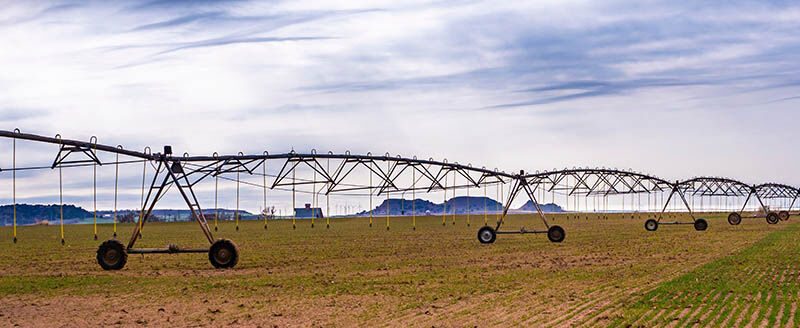9 ways to prepare for a natural disaster
Be ready to protect your farm or ag business if destructive weather comes your way

A natural disaster can strike at any time, with little or no warning. In the High Plains, that can mean a destructive tornado, wildfire or hailstorm.
Experience has shown how deadly and costly natural disasters can be, not just to crops, buildings, vehicles and infrastructure but to humans and livestock, too.
While we can’t prevent extreme weather events, we can minimize their danger and damage by preparing ahead of time. Taking time to getting ready now can help save you thousands of dollars and give you peace of mind when the next disaster or emergency occurs.
Here are some steps you can take to make sure your farm, livestock operation or processing facility is ready before a natural disaster event.
1. Develop a disaster plan. Think through possible disaster scenarios for your area. Then list the steps you must take if one occurs. Identify your internal emergency team. That’s likely to include family members and key employees. Specify their emergency roles and train them on how to respond. Know which key contacts and government agencies should be contacted. That could be anyone from your local police or fire department to your local cooperative or veterinarian to your local U.S. Department of Agriculture Farm Service Agency office. Establish how you will reach out to them. Develop a list of telephone numbers, email addresses and other information, and keep it handy. Everyone should know how to quickly find important contact information, equipment and other resources during an emergency.
2. Build an emergency kit. Include flashlights, spare batteries, power cords and a first-aid kit. You may even want to keep some emergency cash, food and water on hand. Don’t forget plastic sheeting or tarps, duct tape, wire, rope, plywood, chainsaws, and fuel. These essentials can help you respond quickly to collapsed roofs or fences, broken windows or gates and other dangerous conditions. Consider investing in a generator that can supply power during an outage. Store your kit where you can access it easily during and after a storm.
3. Stock up for your animals. Make sure you have extra feed, medications and other animal-health supplies on hand to get you through a few days in case of emergency.
4. Power up your tech. Charge up your smartphone, battery packs and other devices during weather warnings. You want them to be ready to use if your power goes out. Have an external backup battery so you can plug in your modem and router if you need to. It’s also a good idea to have a battery-powered radio.
5. Keep a paper back-up. Power and cellphone service can fail, leaving you without access to the electronic files you compiled. Print out your disaster plan and keep it a binder with emergency contacts and other valuable information handy so you can find the information you need when all else fails.
6. Protect with insurance. Make sure you’re protected by general liability as well as crop insurance. Know what’s covered by insurance and what isn’t. It’s important to understand which disasters—and which property and assets—are covered by insurance. When the destructive wind storms known as derechos hit the nation’s mid-section a couple of years ago, some farmers were stunned to learn their insurance policies didn’t cover that type of natural disaster.
USDA offers a variety of disaster-assistance programs to help farmers, ranchers, communities and businesses hard hit by natural disaster events. Its Disaster Resource Center provides information on how to prepare, recover and build long-term resilience during disasters and emergencies. Farmers.gov is another online site for USDA programs that can help agricultural producers recover.
7. A picture is worth a thousand words. Always document the damage or losses on your farm or facility. Take photos or videos of your farm as it looks today, including livestock, machinery, buildings and other key structures, so you can compare before-and-after appearances. Also make note of when and where the natural disaster occurred, what type it was (such as excessive wind, hail, lightning, tornado) and the impact of the damage (such as to crops, land, feed and buildings).
8. Timeliness matters. If you need assistance after a natural disaster, don’t delay in contacting government agencies. There may be many others seeking financial assistance or recovery help in the aftermath, and you want to be at the front of the line. The various agencies will be gathering damage and loss information after a natural disaster, so stay cool during this process. Do politely insist that your call or email be noted and kept on file.
9. Go online. These websites offer useful information:
• https://www.sba.gov/busines-guide/manage-your-business/prepare-emergencies
• https://www.usda.gov/topics/disaster-resource-center
• https://www.fsa.usda.gov/programs-and-services/disaster-assistance-program/index
Unfortunately, a crisis can happen to any of us. Putting a plan in place now will better equip you to save your business if disaster hits.
Editor’s note: Maxson Irsik, a certified public accountant, advises owners of professionally managed agribusinesses and family-owned ranches on ways to achieve their goals. Whether an owner’s goal is to expand and grow the business, discover and leverage core competencies, or protect the current owners’ legacy through careful structuring and estate planning, Max applies his experience working on and running his own family’s farm to find innovative ways to make it a reality. Contact him at [email protected].


